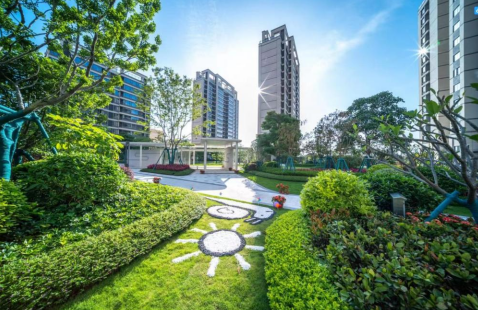Meet customer needs, honor delivery value, develop Poly, and build systematic delivery force.
    Improving the delivery power in an all-round way is not only the embodiment of the social responsibility of housing enterprises, but also a deeper demonstration of their product strength and competitiveness.
    As a central enterprise, Poly Development has always maintained its strength and resilience, adhered to "long-term doctrine", insisted on "creating value for customers" in the first place, attached great importance to delivery, and created and continuously optimized "6321 delivery system". Since 2022, all projects have been delivered on time and with good quality, and customer satisfaction has steadily increased.
    Facing the complicated situation, from "guaranteed delivery" to "quality delivery", how can Poly develop?
    The strength of steady operation is the basis of high-level delivery.
    As one of the few real estate enterprises with double growth, Poly Development has not only maintained a steady increase in revenue and profit, but also won the first opportunity in the market competition.
    The semi-annual report shows that in the first half of the year, Poly Development achieved a total operating income of 110.8 billion, a year-on-year increase of 23.10%; Realized a net profit of 14.924 billion, a year-on-year increase of 1.60%; The net profit of returning to the mother was 10.826 billion, a year-on-year increase of 5.11%.
    In terms of financial security, Poly Development continued to maintain a comprehensive green file. As of the first half of the year, the financing cost of Poly’s development was at a low level in the industry, and three major international rating agencies, such as Standard & Poor’s, Moody’s and Fitch, all gave investment-grade ratings.
    As a head enterprise, Poly Development still maintains its outstanding and leading development ability, and its healthy and steady business indicators undoubtedly set up a responsible image of housing enterprises for the market and owners.
    Insisting on customer thinking is the guarantee of delivering advanced quality.
    Poly development always takes customers as the center, adheres to the customer strategy, and "listens to customers’ voices, improves products and services in combination with customers’ needs, and creates value for customers". After more than ten years of customer satisfaction survey, the National 400 Call Center responded quickly to customers’ demands, invited the owners to attend the site open day before delivery, and took the initiative to conduct home interviews after delivery … "What you see is what you get, and what you show is what you deliver" is the commitment of Poly Development.

    What you see is what you get, thanks to the new construction system and the continuous upgrading of quality. Through the standardization of design products, Poly has developed into a mature, stable and reliable construction system integrating design, material and construction, and continuously iterated the construction system and process standards.
    What you see is what you get, thanks to information empowerment and accurate control of the process. Poly develops the application of "Building a Good Cloud", making the construction process transparent, online, visual and standardized, so that every batch of materials can enter the site and every key process can be checked and accepted.
    What you see is what you get, thanks to the 6321 lean delivery management system, which dynamically controls delivery. Since 2016, Poly Development has taken customer experience as the core, integrated resources and established the 6321 delivery dynamic management method, and combined with external third-party quality evaluation agencies and professional industry service consulting agencies to continuously optimize the management actions before delivery.
    "6321" lean delivery management system is the key to realize quality delivery.
    Nowadays, under the self-demand of constantly listening to customers and lean management, Poly Development has already extended "6321" to front-end quality and back-end service, forming an efficient and powerful grid delivery system, which has not only achieved high-quality delivery on time, but also formed a series of distinctive and customer-satisfied delivery results.
    Before delivery: professional third-party flying inspection, multiple rounds of professional inspection, and comprehensive interception of quality hazards. Poly Development insists on using third-party evaluation agencies such as Ruijie to evaluate and inspect all projects in China, covering the whole construction process from foundation construction to delivery, and iterates the evaluation system every year.
    Under the influence of the epidemic, Shanghai Poly Tianyue Project still fulfilled its high-quality delivery promise as scheduled; Fujian Poly Yunshang Project entered the site in April ahead of schedule, with the elimination of key problems as the primary plan, and five rounds of inspection were carried out according to the classification of working procedures. At the time of final delivery, the number of problems per household was only 0.2.

    Real delivery scene of Poly Development Holding Project
    Delivery period: communicate with the owner’s needs at high frequency, and take the initiative to carry out the site open day, so that the owner can "see" what he sees.
    "Opening the door to welcome guests" and accepting supervision highlight Poly’s confidence and strength. Poly Development is also committed to let every owner witness the "growth of home".
    Jiangxi Company Poly Nanchang Tianhui Project, in conjunction with the government, established a safety standardization site, invited the owners to observe it on the spot, and created the plain appearance of the exhibitors of Poly Ingenuity Factory. The Linyu Project of Baoli West Lake in Shanxi Province aims at "firmly eliminating defects" and invites the owners to visit the site 100%. Hubei Company solidified the owners’ meeting as a standard link, and Nanchang Tianhui Project established a safety standardized site in conjunction with the government, inviting owners to observe on the spot. Four months before Hangzhou Tianhui delivered, the site was opened, the garden was 100% presented, and exclusive owners’ docking was established.

    Hangzhou Poly Tianhui Construction Site Opening Scene
    After delivery: there is a rapid response platform and active and caring service, which reflects the confidence of central enterprises in fulfilling their customers’ promises.
    Poly Development continues to listen to customers’ voices and build a national integrated call center, becoming one of the few real estate enterprises with a headquarters call center. "Zero-delay dispatch" and "8-hour response" are the service features of Poly. Poly Property also launched the "Advanced Quality Action" nationwide, and through the 12 key service scenarios of "Three Hearts and Three Lines", the owners were allowed to transmit the service temperature in high-frequency scenes such as pedestrian moving lines, leisure moving lines and vehicle moving lines, so as to enhance the owners’ perception with high-quality services.

    In the view of Poly Development, delivery is not the end, but the starting point of fulfilling the promise of products and services, and the prime point of providing customers with a better life. With its steady business situation, reliable fund management advantages and full-chain system delivery mechanism, Poly Development has more confidence and ability to achieve "smooth delivery" to "quality delivery".
